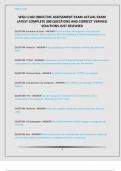Page 1 of 46
WGU C182 OBJECTIVE ASSESSMENT EXAM ACTUAL EXAM
LATEST COMPLETE 300 QUESTIONS AND CORRECT VERIFIED
SOLUTIONS JUST RELEASED
QUESTION: Evolution of Users - ANSWER-First users were the engineers who built and
programmed computers, then employees who had received specialized training were users,
and now today, anyone and everyone can be a user.
QUESTION: Protocol - ANSWER-Rules provided by which networks communicate with each
other.
QUESTION: TCP/IP - ANSWER-Transmission Control Protocol/Internet Protocol. Most commonly
used protocol; is required of all computers that communicate over the Internet.
QUESTION: Protocol Stack - ANSWER-A collection of protocols. TCP/IP is an example.
QUESTION: Components of a Computer - ANSWER-CPU, Memory and Storage, Peripheral
Devices
QUESTION: CPU - ANSWER-Executes programs' instructions and commands various
components in the computer. Referred to as the "chip".
QUESTION: Memory - ANSWER-Stores the programs being executed and the data they are
using.
QUESTION: I/O Subsystem - ANSWER-All peripheral devices where long term storage devices
are used.
QUESTION: Bus - ANSWER-Permits information to move between each component; electrical
channels that enable communication among the electronic components
1
,Page 2 of 46
QUESTION: System Unit - ANSWER-Critical component of all computer based systems; consists
of most of the hardware the computer needs in order to run; comes in a variety of shapes and
sizes.
QUESTION: Internal Components of the System Unit - ANSWER-Case, Internal Bays, Buses,
Ports, Hard Drive, Motherboard, CPU, CPU Cooler, Memory Module (RAM), Power Supply Unit
(PSU), Expansion Slots/Cards
QUESTION: Parts of the CPU - ANSWER-Control Unit (CU) - retrieves the instructions and the
raw data that is input and coordinates or controls the sending of those instructions and data to
the ALU
Arithmetic Logic Unit (ALU) - does the actual processing of the data; completing mathematical
calculations and logical operations to process the data and converting the input of the keyboard
text entry to output displayed on the screen
QUESTION: System Clock - ANSWER-Controls the speed at which instructions are processed.
QUESTION: RAM - ANSWER-Stands for Random Access Memory.
It temporarily stores data before it is processed and sent to your screen or printer.
It is volatile (means data or information stored disappears when the computer is turned off or
loses power).
You can choose the amount of RAM your computer has.
QUESTION: Types of RAM - ANSWER-Dynamic RAM (DRAM) - typically called main memory
Static RAM (SRAM) - cache memory and registers
2
,Page 3 of 46
QUESTION: BIOS ROM - ANSWER-BIOS stands for Basic Input Output System; ROM stands for
Read Only Memory.
Typically stored in ROM chip on the motherboard.
Is software not hardware, ("basic" operating system that runs when the computer is first turned
on).
Runs tests of memory and the CPU and initializes hardware components so that the actual
Operating System can be loaded from the hard disk.
Can't choose the amount or contents.
QUESTION: 1st Generation of Computers - ANSWER-Vacuum tubes, relay switches, the need to
program in machine language
QUESTION: 2nd Generation of Computers - ANSWER-Transistor components, magnetic core
memory, smaller size, easier to program, disk drives and drums, called mainframe computers
QUESTION: 3rd Generation of Computers - ANSWER-Silicon chips (known as ICs - integrated
circuits), reduced cost, called mini computers, networks introduced via dumb terminals
QUESTION: 4th Generation of Computers - ANSWER-Single chip processor, called
microcomputer, first personal computer, rudimentary computer graphics, home use
QUESTION: Moore's Law - ANSWER-Doubling of transistor count roughly every 18 - 24 months
(exponential increase)
3
, Page 4 of 46
QUESTION: Evolution of Storage - ANSWER-Punch cards, magnetic tape, hard disks, floppy disks,
optical discs, flash memory, cloud storage
QUESTION: Machine/Low-level Language - ANSWER-Written for a specific machine by the
engineers who built and ran the computers; no need for OS since only one program could run
at a time
QUESTION: Assembly Language - ANSWER-Easier than machine but still required detailed,
precise low level instructions
QUESTION: Language Translator Programs - ANSWER-Function is to translate one program
language into another; take source code and convert it to another form; source code by itself
cannot be read by a computer
QUESTION: Compiler - ANSWER-Improve language translator; requires that the components of
the software all be defined before compilation can begin; code is more effcient
QUESTION: Structured Programming - ANSWER-Programmer is limited to high level control
constructs such as while loops, for loops, and if/else statements and not allowed to use
primitive GOTO statements
QUESTION: Object Oriented Programming - ANSWER-Characterized by the creation of
windowed operating systems, easier real-world object modeling in programming code, and the
application of inheritance in program code.
QUESTION: Interpreted Code - ANSWER-A type of programming language for which most of its
implementations execute instructions directly and freely, without previously compiling a
program into machine-language instructions.
QUESTION: Shell Scripting - ANSWER-Small programs that place Linux commands or DOS batch
files into a file
4




